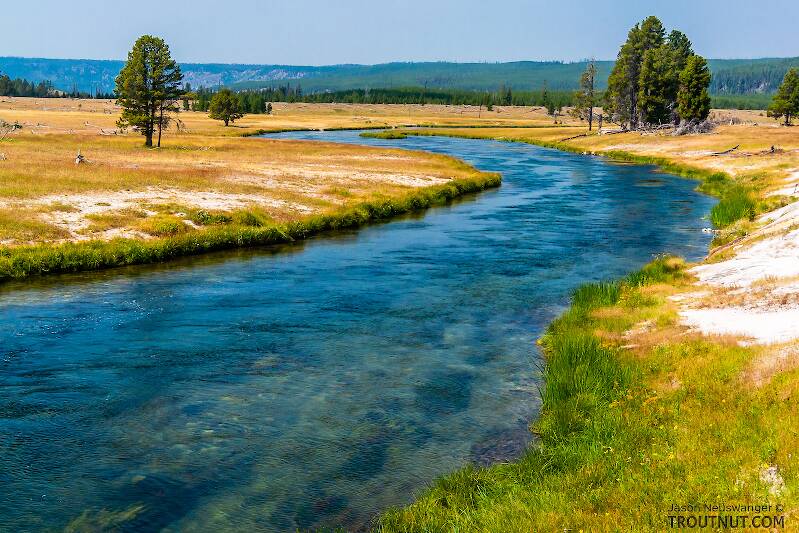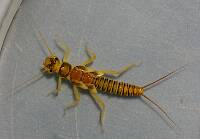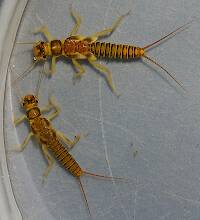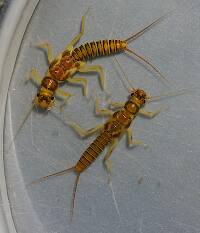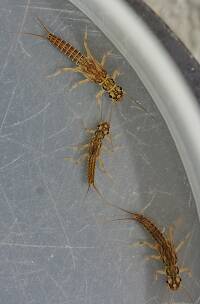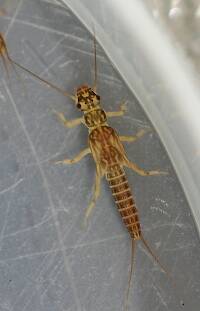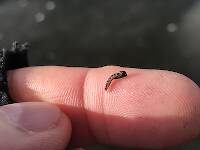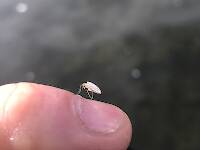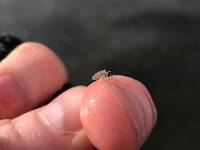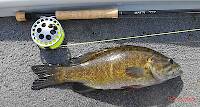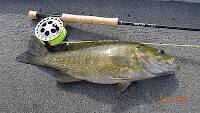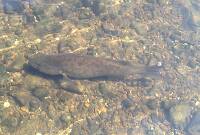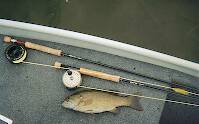
Hex Mayflies
Hexagenia limbata
The famous nocturnal Hex hatch of the Midwest (and a few other lucky locations) stirs to the surface mythically large brown trout that only touch streamers for the rest of the year.
Featured on the forum

This one seems to tentatively key to Holocentropus, although I can't make out the anal spines in Couplet 7 of the Key to Genera of Polycentropodidae Larvae nor the dark bands in Couplet 4 of the Key to Genera of Polycentropodidae Larvae, making me wonder if I went wrong somewhere in keying it out. I don't see where that could have happened, though. It might also be that it's a very immature larva and doesn't possess all the identifying characteristics in the key yet. If Holocentropus is correct, then Holocentropus flavus and Holocentropus interruptus are the two likely possibilities based on range, but I was not able to find a description of their larvae.

Troutnut is a project started in 2003 by salmonid ecologist Jason "Troutnut" Neuswanger to help anglers and
fly tyers unabashedly embrace the entomological side of the sport. Learn more about Troutnut or
support the project for an enhanced experience here.
Shawnny3 on Jul 29, 2011July 29th, 2011, 8:08 pm EDT
Tonight we encountered a large batch of rising trout on a Central PA stream that were only marginally interested in the size 20-22 baetis that were coming off sporadically. A closer inspection of the insects drifting downstream revealed that a disproportionately large number of them were what appeared to be flying ants. They were black, size 20, with gray wings that folded onto their backs in a heart shape when they perched on the water. The bodies were in three distinct segments and very thin between the segments. There were a lot of them, most of them caught in the film, but some rode the water like experienced sailors. We switched over to a black biot baetis emerger and got much more eager takes. Fun fishing a "hatch" of what I presume are terrestrials. Sorry not to have any pics. Any ideas as to what we were seeing, and have others ever fished a similar "hatch"?
-Shawn
-Shawn
Jewelry-Quality Artistic Salmon Flies, by Shawn Davis
www.davisflydesigns.com
www.davisflydesigns.com
Entoman on Jul 29, 2011July 29th, 2011, 8:57 pm EDT
Hi Shawn,
Yes, quite a bit over the years, though more than I care to admit were times only discovered from inspecting fish entrails.:) Unless the light is right, they are virtually impossible to see on the water when they are that small. Kudos to your observational skills!
Were the abdomens roundish oval or more elongate? If the former ants, if the latter termites. Either can be black and hold their wings in the semi-spent heart shape you mentioned. If termites, they are the subterranean kind, not the woodland types that live in rotting wood. They can live to amazing depths, limited only by the layers of the topsoil over bedrock. Some colonies have been found as deep as a hundred ft!
Sounds like you had a good time!
Regards,
Kurt
Yes, quite a bit over the years, though more than I care to admit were times only discovered from inspecting fish entrails.:) Unless the light is right, they are virtually impossible to see on the water when they are that small. Kudos to your observational skills!
Were the abdomens roundish oval or more elongate? If the former ants, if the latter termites. Either can be black and hold their wings in the semi-spent heart shape you mentioned. If termites, they are the subterranean kind, not the woodland types that live in rotting wood. They can live to amazing depths, limited only by the layers of the topsoil over bedrock. Some colonies have been found as deep as a hundred ft!
Sounds like you had a good time!
Regards,
Kurt
"It's not that I find fishing so important, it's just that I find all other endeavors of Man equally unimportant... And not nearly as much fun!" Robert Traver, Anatomy of a Fisherman
Shawnny3 on Jul 30, 2011July 30th, 2011, 4:56 am EDT
Thank you, Kurt. The possibilities you've presented prompted me to look at a bunch of pics online. I'm pretty certain after that that these were ants, not termites. A thunderstorm blew through during the afternoon, about 3 hours before we fished over the rising fish. Could that have had anything to do with their being on the water, I wonder?
Credit goes to Duane for noticing them. He was rigged for nymphing, so he was standing there watching me fish for awhile and took the time to do something we'd all probably be wise to do intentionally more often - take a look around and try to figure out what's going on. I had been fooling with dries for much of the day, and thought I had a decent handle on what was coming off, but when I finally saw a group of fish really feeding on the surface, I ignored doing more research and started eagerly casting. He started looking in the water, and it was only after he said, "There's another one," for the tenth time in a minute that I was convinced that the fish might not be feeding on baetis. After I'd caught several, I lent Duane my rod, we got him rigged up with a darker fly, and every fish that was presented with that fly took it. It was a fun way to end a tough day.
Next time I head to the stream I will not be without some flying ant imitations, both dry and wet.
-Shawn
Credit goes to Duane for noticing them. He was rigged for nymphing, so he was standing there watching me fish for awhile and took the time to do something we'd all probably be wise to do intentionally more often - take a look around and try to figure out what's going on. I had been fooling with dries for much of the day, and thought I had a decent handle on what was coming off, but when I finally saw a group of fish really feeding on the surface, I ignored doing more research and started eagerly casting. He started looking in the water, and it was only after he said, "There's another one," for the tenth time in a minute that I was convinced that the fish might not be feeding on baetis. After I'd caught several, I lent Duane my rod, we got him rigged up with a darker fly, and every fish that was presented with that fly took it. It was a fun way to end a tough day.
Next time I head to the stream I will not be without some flying ant imitations, both dry and wet.
-Shawn
Jewelry-Quality Artistic Salmon Flies, by Shawn Davis
www.davisflydesigns.com
www.davisflydesigns.com
Oldredbarn on Jul 30, 2011July 30th, 2011, 9:06 am EDT
Next time I head to the stream I will not be without some flying ant imitations, both dry and wet.
Shawn,
I was burnt this way myself years back and came to the same conclusion you have...Never leave home without them...Ants that is.
It was a nice warm day on the South Branch of the Au Sable...Absolutely nothing going on...But every time the wind would blow I'd see splashy rises just below the tag alders...I couldn't figure it out...Then after a couple times of brushing them off me I realized that the breeze was knocking ants from the over hanging trees...How slow can a guy be?! :)
Spence
"Even when my best efforts fail it's a satisfying challenge, and that, after all, is the essence of fly fishing." -Chauncy Lively
"Envy not the man who lives beside the river, but the man the river flows through." Joseph T Heywood
"Envy not the man who lives beside the river, but the man the river flows through." Joseph T Heywood
Falsifly on Jul 30, 2011July 30th, 2011, 9:20 am EDT
I have experienced this phenomenon on a yearly basis but it is short lived and seldom coincides with me being on the water. Some years ago I made a point to fish it when I noticed the swarms developing, but had no success.
Flying Ants
Flying Ants
Falsifly
When asked what I just caught that monster on I showed him. He put on his magnifiers and said, "I can't believe they can see that."
When asked what I just caught that monster on I showed him. He put on his magnifiers and said, "I can't believe they can see that."
Entoman on Aug 3, 2011August 3rd, 2011, 10:55 am EDT
Shawn -
It seems to be conventional wisdom that ant/termite swarms are over land and that wind or thunderstorms are the cause for driving them to water. This may be true but I've had enough experiences over the years with them swarming over water on blue bird days that this isn't always the case. I have found this to be particularly true with the big Carpenter Ants on mid elevation Sierra lakes that have heavily forested banks.
Allan -
This is my experience as well. It is a phenom one should be prepared for but shouldn't expect (let alone predict). Typically, they only occur for a day or two at any time in a four month period depending on year and elevation. Couple this with ebbs and flows of population densities...
Exactly... They have to be on the water with fish actually working them or your imitation is just an attractor. Sometimes they work very well at this even when fish are working aquatics. Perhaps this is the reason the patterns are often given credit for "hatch matching" when anglers see swarms or lots of ants on the shore.
In keeping with the desire to keep the flyboxes I carry to a minimum, I only tie patterns with wings (except size 12's & 14's which I'll explain below). They are easy to trim off if you need to and reduces the flies you need to carry by half. I tie the 16's and smaller with a short post of zlon for visibility with the wings tied in underneath the parachute. I've tried all kinds of wing materials but have settled on medalion sheeting (in brown and lt. gray) as the best stuff. Fold it and trim to shape for that heart shaped look. I've found only two body colors are needed, brown in different shades depending on size, and black (with hackle to match on the parachutes). Sizes 12 and 14 are tied with a standard hackle waist of brown or dun depending on wing color. I've just had as good or better luck with them over the years in this size range and they are much easier to tie. These are also the sizes I use most when used as attractors so that may be the reason. I get creative with the larger sizes (extended bodies and stuff). The medalion sheeting is fragile stuff and starts to shread and curl after extensive use, but if anything this improves their effectiveness. In the larger sizes the stuff flies by overhead with a flag flapping sound (which is a little annoying), but it doesn't twist leaders like stiffer material can do. Hopefully I'll get my act together soon with the camera to download some photos.:)
Regards,
Kurt
A thunderstorm blew through during the afternoon, about 3 hours before we fished over the rising fish. Could that have had anything to do with their being on the water, I wonder?
It seems to be conventional wisdom that ant/termite swarms are over land and that wind or thunderstorms are the cause for driving them to water. This may be true but I've had enough experiences over the years with them swarming over water on blue bird days that this isn't always the case. I have found this to be particularly true with the big Carpenter Ants on mid elevation Sierra lakes that have heavily forested banks.
Allan -
I have experienced this phenomenon on a yearly basis but it is short lived and seldom coincides with me being on the water.
This is my experience as well. It is a phenom one should be prepared for but shouldn't expect (let alone predict). Typically, they only occur for a day or two at any time in a four month period depending on year and elevation. Couple this with ebbs and flows of population densities...
Some years ago I made a point to fish it when I noticed the swarms developing, but had no success.
Exactly... They have to be on the water with fish actually working them or your imitation is just an attractor. Sometimes they work very well at this even when fish are working aquatics. Perhaps this is the reason the patterns are often given credit for "hatch matching" when anglers see swarms or lots of ants on the shore.
In keeping with the desire to keep the flyboxes I carry to a minimum, I only tie patterns with wings (except size 12's & 14's which I'll explain below). They are easy to trim off if you need to and reduces the flies you need to carry by half. I tie the 16's and smaller with a short post of zlon for visibility with the wings tied in underneath the parachute. I've tried all kinds of wing materials but have settled on medalion sheeting (in brown and lt. gray) as the best stuff. Fold it and trim to shape for that heart shaped look. I've found only two body colors are needed, brown in different shades depending on size, and black (with hackle to match on the parachutes). Sizes 12 and 14 are tied with a standard hackle waist of brown or dun depending on wing color. I've just had as good or better luck with them over the years in this size range and they are much easier to tie. These are also the sizes I use most when used as attractors so that may be the reason. I get creative with the larger sizes (extended bodies and stuff). The medalion sheeting is fragile stuff and starts to shread and curl after extensive use, but if anything this improves their effectiveness. In the larger sizes the stuff flies by overhead with a flag flapping sound (which is a little annoying), but it doesn't twist leaders like stiffer material can do. Hopefully I'll get my act together soon with the camera to download some photos.:)
Regards,
Kurt
"It's not that I find fishing so important, it's just that I find all other endeavors of Man equally unimportant... And not nearly as much fun!" Robert Traver, Anatomy of a Fisherman
Oldredbarn on Aug 3, 2011August 3rd, 2011, 12:44 pm EDT
Hopefully I'll get my act together soon
Hmmm....;)
Spence
An anedote to back your thoughts up...I can't tell you how many times I've left the gym with my wife, late summer/early fall, only to see the martins working the flying ants like crazy. When we get to the car they are on the windshield and I just want to put my head down in to my hands...My poor wife has to hear again, "If only this were happening on the Au Sable!" I have had a flying ant fall when I was actually on the river once and it was a warm-water bass stream...
"Even when my best efforts fail it's a satisfying challenge, and that, after all, is the essence of fly fishing." -Chauncy Lively
"Envy not the man who lives beside the river, but the man the river flows through." Joseph T Heywood
"Envy not the man who lives beside the river, but the man the river flows through." Joseph T Heywood
Sayfu
Posts: 560
Posts: 560
Sayfu on Aug 18, 2011August 18th, 2011, 7:56 am EDT
Interesting analysis of flying ants was recently published by Rick Hafele. A colony doesn't have some flying ants, and others that are not, or have none fliers that develop wings, but a distinct group of ants created to fly off and create new colonies, and can reproduce. They can end up in the water for whatever reason, and once an ant is on the water he is stuck there, and can not fly off like a hopper can. Problem is the unpredictability when you can expect to see them on the water...Aug on seems to be the best time.
Entoman on Aug 18, 2011August 18th, 2011, 5:07 pm EDT
Hi Sayfu -
Do you remember the reference for Hafele's article? I'd like to read what he has to say.
My understanding of Ants is that if conditions are right, in addition to a multitude of workers their broods will also produce a good number of males and a small group of gynes. Both have wings and engage in mating flights. When these flights are completed and the gynes have chosen mates, both quickly drop their wings. The gynes go off to form their own colonies and are then called queens. Though there are exceptions (as there often seems to be in entomology), ants normally have one queen per colony. This is a trait they share with bees which are from a different family but same order (Hymenoptera).
Their family name is Formicidae and their are dozens of different genera. They get their family name from the Latin formica, meaning ant. They have an acrid peppery smell (and I assume taste). This is due to a high concentration of an acid named after them called formic acid. They come in a variety of sizes and colors, with most being black or some shade of brown, often with red or orange highlights. Two-tone varieties are also common.
Two speculations:
Many angler's entertain the notion that ants are trout Mexican food though I'm more inclined to Thai.:) Sometimes they're in the mood for a spicy meal, sometimes not... I'm not aware of any scientific support for this conjecture.
The second one is that sometimes you will find a fair concentration of wingless ants on the water when normally they rarely make it there. One idea is that it comes from earth breaking away, dropping a colony into the water. This probably does happen but doesn't explain the steady trickles that often float by. Wonder if it could be males expiring from streamside perches after they have dropped their wings? I don't think they are allowed back in the colonies. Hmm...
Kurt
Do you remember the reference for Hafele's article? I'd like to read what he has to say.
My understanding of Ants is that if conditions are right, in addition to a multitude of workers their broods will also produce a good number of males and a small group of gynes. Both have wings and engage in mating flights. When these flights are completed and the gynes have chosen mates, both quickly drop their wings. The gynes go off to form their own colonies and are then called queens. Though there are exceptions (as there often seems to be in entomology), ants normally have one queen per colony. This is a trait they share with bees which are from a different family but same order (Hymenoptera).
Their family name is Formicidae and their are dozens of different genera. They get their family name from the Latin formica, meaning ant. They have an acrid peppery smell (and I assume taste). This is due to a high concentration of an acid named after them called formic acid. They come in a variety of sizes and colors, with most being black or some shade of brown, often with red or orange highlights. Two-tone varieties are also common.
Two speculations:
Many angler's entertain the notion that ants are trout Mexican food though I'm more inclined to Thai.:) Sometimes they're in the mood for a spicy meal, sometimes not... I'm not aware of any scientific support for this conjecture.
The second one is that sometimes you will find a fair concentration of wingless ants on the water when normally they rarely make it there. One idea is that it comes from earth breaking away, dropping a colony into the water. This probably does happen but doesn't explain the steady trickles that often float by. Wonder if it could be males expiring from streamside perches after they have dropped their wings? I don't think they are allowed back in the colonies. Hmm...
Kurt
"It's not that I find fishing so important, it's just that I find all other endeavors of Man equally unimportant... And not nearly as much fun!" Robert Traver, Anatomy of a Fisherman
Sayfu
Posts: 560
Posts: 560
Sayfu on Aug 19, 2011August 19th, 2011, 5:08 am EDT
Entomen..Hafele was quoted by author Jim Mclennan in the Aug.-Sept issue of Fly Fisherman Mag. Rick says, "at the right time a colony produces a distinct group of new ants specifically designed to start new colonies." Good article entitled, "Small Bites"
GONZO on Aug 19, 2011August 19th, 2011, 5:11 am EDT
Their family name is Formicidae and their are dozens of different genera. They get their family name from having a high concentration of formic acid, giving them an acrid peppery smell (and I assume taste).
I believe you have that backward, Kurt. Ants don't get their family name from formic acid; formic acid gets its name from ants (formica in Latin).
Entoman on Aug 20, 2011August 20th, 2011, 10:56 am EDT
Lloyd -
You are absolutely right. I will correct the error. Thanks for keeping me honest.:)
Sayfu - Thanks for the heads up on the article. I'll check it out.
Kurt
You are absolutely right. I will correct the error. Thanks for keeping me honest.:)
Sayfu - Thanks for the heads up on the article. I'll check it out.
Kurt
"It's not that I find fishing so important, it's just that I find all other endeavors of Man equally unimportant... And not nearly as much fun!" Robert Traver, Anatomy of a Fisherman
Quick Reply
Related Discussions
Topic
Replies
Last Reply
4
May 11, 2017
by Millcreek
by Millcreek

